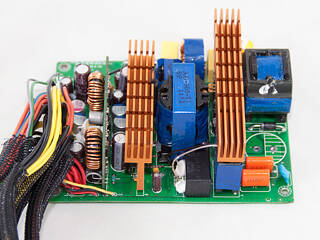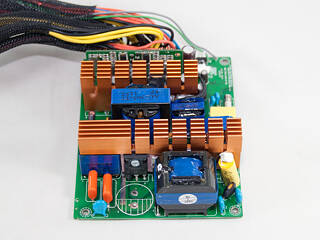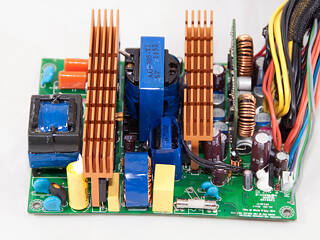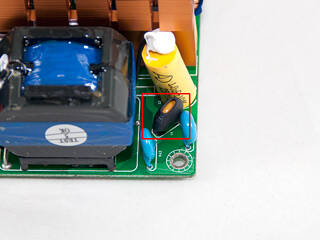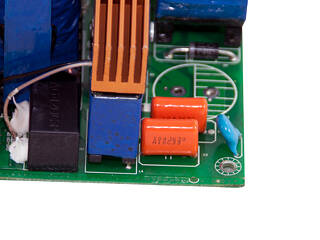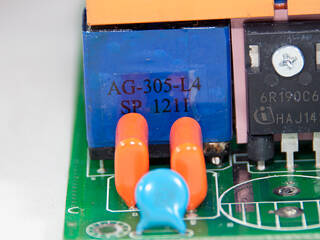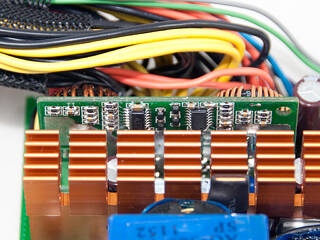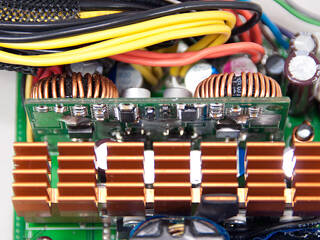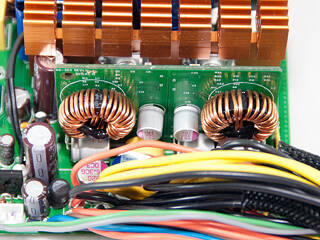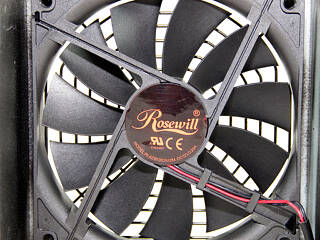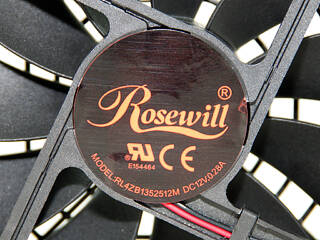 0
0
Rosewill Fortress 550 W Review
Voltage Regulation & Efficiency »A Look Inside
Before reading this page, we strongly suggest you take a look at this article, which will help you understand much better the internal components of a PSU.The OEM of all Fortress units is ATNG, a manufacturer that we seldom hear about but still has some rather interesting platforms to exhibit. When we remove the top part of the case, we can see a really small PCB which could easily be housed in a much smaller casing. Nevertheless, Rosewill most likely wanted to use the same thing for all Fortress units. This PSU uses a modern platform to achieve Platinum-level efficiency, since on the primary side we can see an LLC resonant converter, while on the secondary side, two DC-DC converters generate the minor rails and the +12V rails are rectified by mosfets (active or synchronous rectification).
Behind the AC receptacle is a small PCB housing many transient filtering components such as two pairs of X and Y caps, as well as a CM choke.
The transient filter continues on to the main PCB with two additional pairs of X and Y caps, a CM choke, and an MOV which, strangely enough, is located after the bridge rectifier and the PFC input cap.
The single-bridge rectifier is bolted onto the main heatsink.
In the APFC, a single FET, most likely a IPW60R190CP, separates the intermediate DC voltage coming from the bridge rectifier into constant pulse sequences and a boost diode (CREE C3D06060) boosts the pulsating rectified mains up to a loosely regulated ~380 V DC bus voltage. The single hold-up cap is provided by Nichicon (400 V, 330 µF, 105°C). As main switches, two IPW60R190CP transistors are used.
The PFC controller is installed on this small vertical daughterboard and its model number is CM6502S.
The two orange caps along with the inductor hidden under the main heatsink are the main parts of the LLC resonant converter.
The standby PWM controller is an STR-A6059H IC.
On the secondary side, the +12V rail handles four IPP041N04N FETs. Moreover, two DC-DC converters generate the minor rails from +12V. At each VRM, we find a dedicated PWM controller and two FETs.
On the secondary side, mostly polymer caps are used, all provided by Capxon except one made by Teapo; we can also see some Nippon Chemi-Con electrolytic caps rated at 105°C (KY series).
Soldering quality on the main PCB is not that good, especially on the secondary side where there are many ugly and blobby solder joints. These solder joints may have no effect on the performance of the unit, but, definitely, they are unsightly for a reviewer. On this side, the LLC resonant controller is also soldered, a CM6901 IC.
The cooling fan carries Rosewill's logo, but its model number, RL4Z-B1352512M (12 V, 0.28 A), reveals its real OEM which is Globefan. It uses double ball bearings, so it will last quite long and is very quiet at all times, as we have discovered during our test sessions.
Jan 8th, 2025 21:17 EST
change timezone
Latest GPU Drivers
New Forum Posts
- Are people planning an upgrade? (13)
- All RTX 5090s only have 1x 16-pin connector (39)
- What are you playing? (22540)
- Help me understand the direction of VR and its decisions (7)
- Technical Issues - TPU Main Site & Forum (2024) (505)
- NVIDIA has revealed the prices for the RTX 5090, 5080 and 5070 (153)
- Flashing 4090 MSI Ventus 3x E OC (1)
- AMD Phenom II X6 1090T - Upgrade AM4 / AM5 / Intel Advice - Keep the 1080ti. (33)
- TPU's Nostalgic Hardware Club (19756)
- Overclocking My System Advice for CPU, RAM, and GPU (26)
Popular Reviews
- ASUS ROG Strix B850-F Gaming WiFi Review
- AMD Ryzen 7 9800X3D Review - The Best Gaming Processor
- DDR5 Thermal Testing & Analysis
- GPU Test System Update for 2025
- Call of Duty: Black Ops 6 Performance Benchmark Review - AMD FTW
- Upcoming Hardware Launches 2024 (Updated Nov 2024)
- SCYROX V8 Review
- Intel Arc B580 Review - Excellent Value
- Klevv Genuine G560 2 TB Review
- HEDDphone TWO GT Air Motion Transformer Headphones Review
Controversial News Posts
- NVIDIA 2025 International CES Keynote: Liveblog (434)
- AMD Debuts Radeon RX 9070 XT and RX 9070 Powered by RDNA 4, and FSR 4 (318)
- NVIDIA GeForce RTX 5090 Features 575 W TDP, RTX 5080 Carries 360 W TDP (208)
- AMD Radeon RX 9070 XT Alleged Benchmark Leaks, Underwhelming Performance (204)
- Potential RTX 5090 and RTX 5080 Pricing in China Leaks (173)
- 32 GB NVIDIA RTX 5090 To Lead the Charge As 5060 Ti Gets 16 GB Upgrade and 5060 Still Stuck With Last-Gen VRAM Spec (173)
- AMD Radeon RX 9070 XT Boosts up to 3.10 GHz, Board Power Can Reach up to 330W (167)
- NVIDIA GeForce RTX 5070 Ti Leak Tips More VRAM, Cores, and Power Draw (161)
